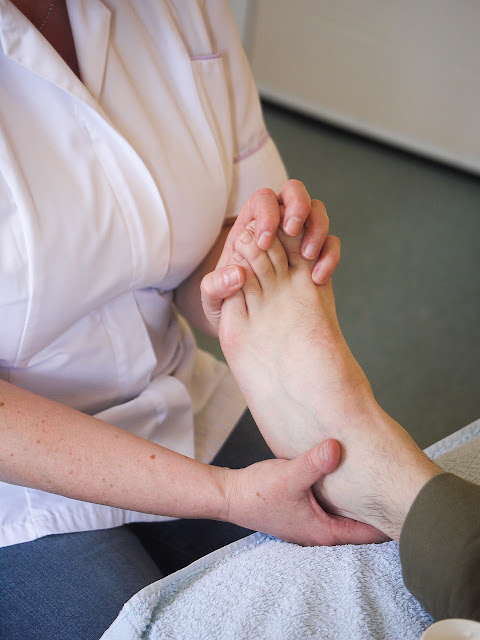A foot fracture is any break of the bone or bones in the foot. This is fairly common among people who have met accidents wherein the foot is one part of the body that was injured. It can also be brought about by “abuse” of the feet, which means using it beyond its normal capacity to handle stress. Since a foot has 26 small bones and are at the receiving end of our body, our feet are very prone to twisting and slipping. According to studies, 10 percent of broken bone injuries suffered by people happen in the foot
Types
Foot fractures are classified into different types depending on their site of injury so we have the category of simple foot fractures and compound foot fractures. Simple fractures only have one fracture on a single foot while compound fractures have more fractures. Here are the other types of foot fractures:
• Fractures of the toe. Toes are technically known as the phalanges and it is very common for people to have fractured toes. A fractured toe may only need splinting or buddy taping so that the injured toe will be given support by taping them together. For the big toe when fractured, this could be very painful and may require surgery if there are fragmented bones in it.
• Fractures of the sesamoid. These are fractures of the bones that are below the toe. People get these fractures from jumping, running or using the ball of their foot during games like badminton and basketball. These fractures require casting and the use of special insoles to minimize pain after the casting. If it still hurts then the sesamoid bone must be surgically removed.
• Stress fractures. It does not mean the bones here are really fractured but there could be swelling or a splinter of a bony part that comes out from other bone. Because the muscles pull the bones, the surface of the bone come off as a result. This usually happens in the metatarsals. Resting the foot for a while is the best treatment for this kind of foot fracture but crutches could also help until the bone goes back to its normal condition.
• Avulsion fractures. These are caused by the sudden turning of the foot inward or the turning of the foot outside the corner, which could cause the middle part to break. Casting or splinting the food may be necessary.
• Ankle fractures. These can occur during falls and the ankle rolls or twists outwards or inwards. This fracture can be corrected by casting.
• Malleoli fractures. Considered as serious fractures because the bony bumps on the outside and inside of the ankle are both fractured and very painful. Casting may also be required.
Foot Fractures Diagnosis
The doctor will ask the patient to get a foot x-ray especially if pain is severe but he will also conduct thorough examination by asking the patient where it hurts more. The doctor will slightly push the base of metatarsal bone and the navicular bone to see if these are damaged. If severe bone crushes are suspected, bone scan, ultra sound or an MRI should be performed to check other hidden injuries that cannot be revealed by x-rays.
Foot Fracture Causes
Foot fractures are commonly the result of crushing, bending, twisting, or stretching of the bone beyond their normal limitations. When you kick on something hard with your toes this can break the bone in it. Trauma and falls can also cause the fractures. Accidents on the foot can also cause fractures. Additionally, with abuse, small cracks will develop in the bones and will then result in stress fractures. In children, their metatarsals and phalangeal bones are where fractures usually occur.
Foot Fracture Symptoms
• There will be swelling and pain when there is a broken bone but most toe fractures are not that painful and they do not swell so badly.
• Redness or bruises will appear on the broken site.
• The person cannot be able to stand firmly and if tried this could be painful especially if the break is in the metatarsal.
Foot Fracture Treatment
Elevating the injured foot to stabilize the blood flow is a must. Splinting the foot before the person will be brought to the hospital is necessary too so that it will be immobilized. You can also use a thin pillow to wrap it around the foot and then bandage it. For injured toes that are not deformed, these do not need actually need medical attention unless internal bleeding and severe symptoms appear. At home, you can place padding like cotton balls on both sides of the injured toes and tape the two good toes along with a medical tape.
For broken bone in the foot, if the foot fracture is severe this may require surgery to reassemble the bones. For not so serious break, casting or splinting the foot is enough. Crutches will be needed by the patient so that he can still move and exercise his damaged foot. Non-bearing weight may or may not be recommended by your doctor depending on the condition of your foot fracture.
Prevention
Preventing foot fracture is always better than treating them so better bear in mind to always practice foot care by wearing well-fitting shoes especially if you are an athlete, works on a construction site, motorcycling or simply a jogger. Be very cautious not to put your foot in danger such as placing your feet where they can be at high risk of getting hit by something hard and heavy.

Comments
Post a Comment
Please do not enter any spam link in the comment box.